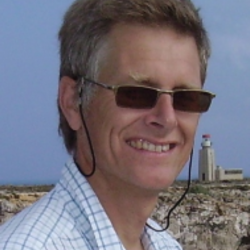
Machine learning has emerged as a promising tool to analyze massive amount of data. ML has demonstrated impressive results in non-physical sciences. ML has solid footing in statistics and signal processing. In this talk I will highlight three machine learning applications in geophysics:
Graph theory: A model-free technique is used to identify weak sources within dense sensor arrays using graph clustering. No knowledge about the propagation medium is needed. We use the spatial coherence matrix of a wave field as a matrix whose support is a connectivity matrix of a graph with sensors as vertices. The support of the covariance matrix is estimated from limited-time data using a hypothesis test with a robust phase-only coherence test-statistic. The method is applied to a dense 5200 element geophone array that blanketed 7 km ×10 km of the city of Long Beach (CA).
Compressive sensing: Sound source localization with sensor arrays involves the estimation of the direction-of-arrival (DOA) from a limited number of observations. Compressive sensing (CS) solves such underdetermined problems achieving sparsity, thus improved resolution, and can be solved efficiently with convex optimization. The DOA is formulated in the CS framework and is shown that CS has superior performance compared to traditional DOA methods especially under challenging scenarios such as coherent arrivals and single-snapshot data. The high-resolution capabilities and the robustness of CS are demonstrated on experimental array data from ocean acoustic for source tracking and for showing the evolution earthquakes.
Dictionary learning: Inversion of ocean acoustic sound speed profiles (SSPs) requires inversion of acoustic data with limited observations. Traditional regularization, which minimizes the energy of best-fit solutions, requires undersampling of true SSPs or using few shape functions. This gives low resolution SSP estimates which can affect the accuracy of other parameters in geoacoustic inversion. Here, it is shown that ocean SSPs can be compressed using learned dictionaries of shape functions. These optimal dictionaries are used with CS to estimate SSPs by inverting a linearized normal mode model. It is shown that range-independent ocean SSPs are estimated robustly and in high resolution with few parameters using CS.
tqn001@eng.ucsd.edu
